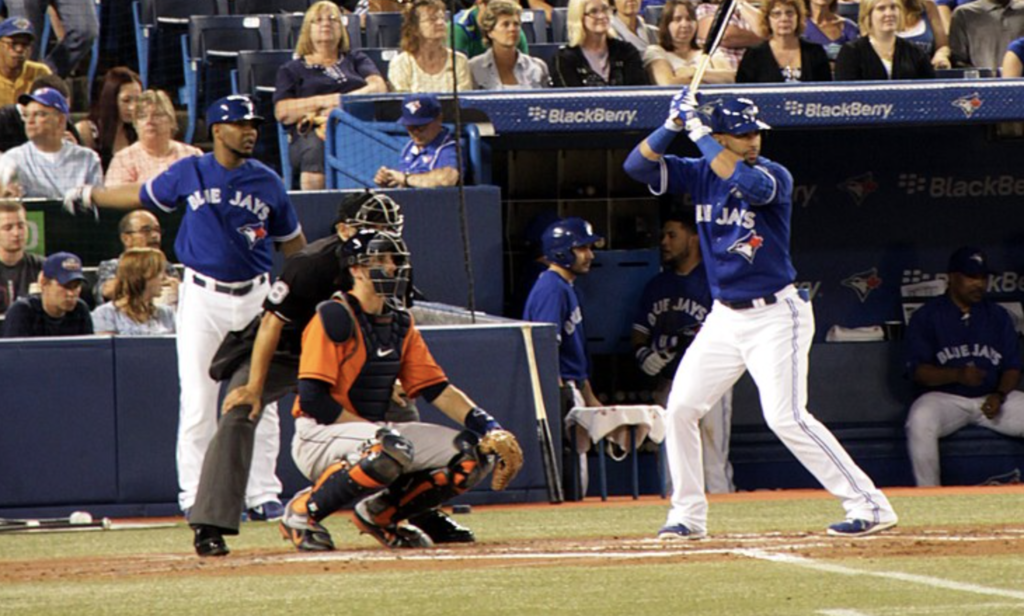
Throughout the history of Major League Baseball (MLB) there have been countless iconic international players. Ichiro Suzuki from Japan, Roberto Clemente from Puerto Rico, and Miguel Cabrera from Venezuela, just to name a few. Featuring players from across the globe, MLB teams are a plethora of cultures, skillsets, and approaches to the game.
MLB is a truly global league, but no foreign country seems to play a bigger role than the Dominican Republic. In 2020 alone, there were 110 Dominican MLB players. Some, like Juan Soto, Fernando Tatis, Jr., and Vladimir Guerrero, Jr., have solidified themselves as the game’s brightest young stars, garnering attention for their fantastic play and passion for the game.
In brainstorming how to feature the greatest Dominican ballplayers, we first tried to come up with the all-time starting nine, but that was far too difficult to narrow down. Instead, we tried to come up with a 25-man roster, but even that couldn’t do the topic justice. As a result, we created a 40-man roster, complete with a coaching staff and front office, and “Tomorrow’s Team,” featuring the players, coaches, and front office members whose stories are not yet completely told. In this five-part series, we’ll cover the best Dominican players to ever put on the uniform, divided into five categories: infielders and catchers, outfielders, pitchers, coaching staff and front office, and “Tomorrow’s Team.”
(For this list, we decided to limit our selection to the players who spent a majority of their formative years in the D.R. As a result, players of Dominican heritage that were raised in the U.S., like Alex Rodriguez and Manny Machado, will be left off this list.)
All set? Good. Let’s begin the week with the infielders and catchers.
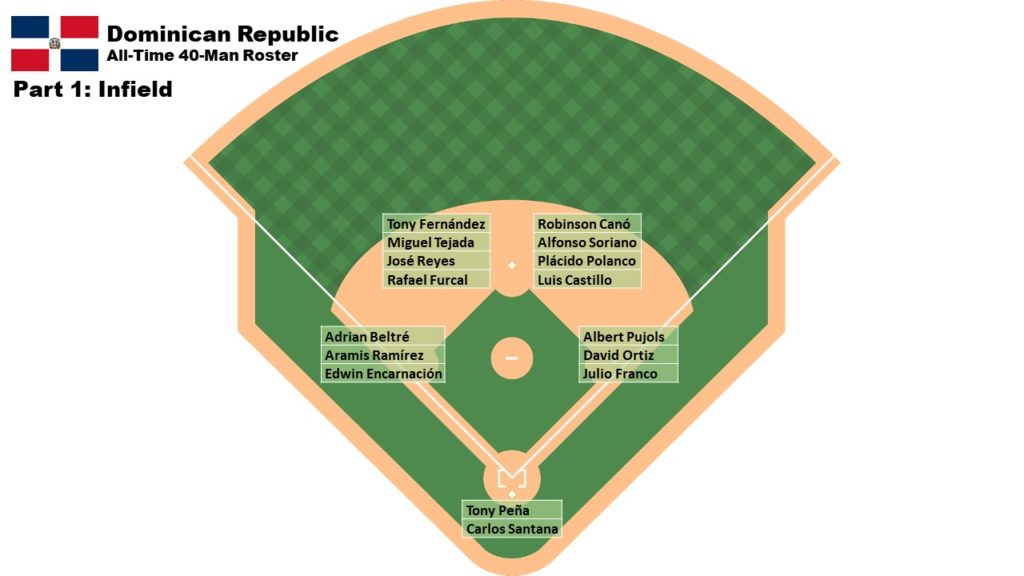
First Base:
Albert Pujols
From Santo Domingo
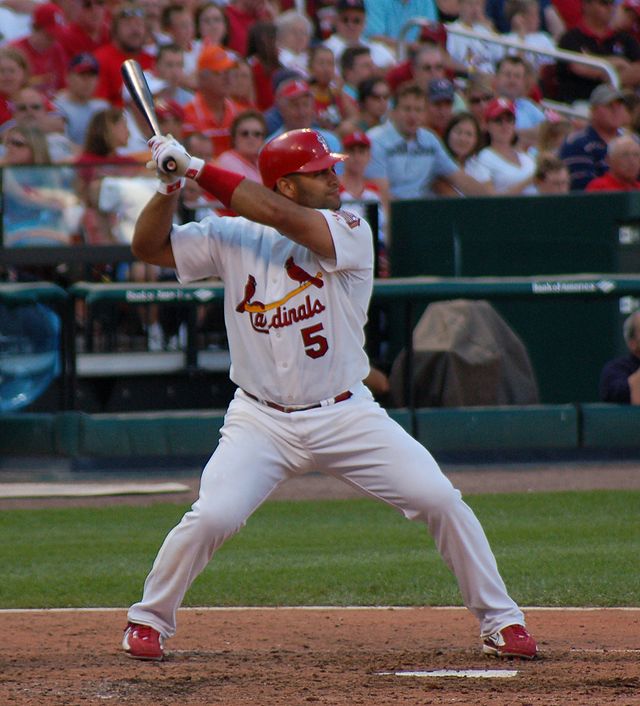
Come on. You knew this was coming. Pujols is simply one of the greatest hitters to ever play the game.
He could have retired after his first 11 seasons in the big leagues, all with the St.Louis Cardinal, and still be a legend. His average season as a Cardinal looked like this: .328 BA, .410 OBP, 41 HR, and 120 RBI. He won three National League MVP awards in St. Louis, and finished in the top five in voting all of the other years except for one, in which he finished ninth. Beyond the batting excellence, however, Pujols earned legend status by leading the Cardinals to two World Series titles.
Pujols also sits high on several all-time total lists, including RBIs (2,100, 3rd all-time), hits (3,236, 15th all-time), and home runs (662, 5th all-time), as well as winning six Silver Sluggers and two home run titles. Although he’s become a relic of the past during his time with the Los Angeles Angels, he will always be remembered fondly for his time with the Cardinals, evidenced by this standing ovation he received as a visiting player:
Cooperstown awaits for this legendary slugger.
David Ortiz
Santo Domingo
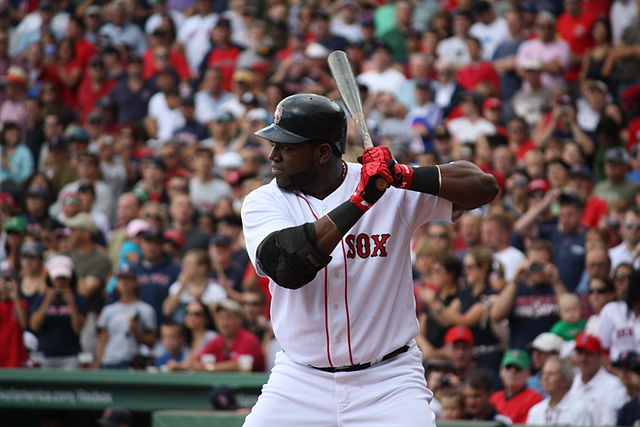
Ortiz, who came up through the minors as a first baseman and played first base in interleague play, was one of the most important players in Boston Red Sox history, helping break the “Curse of the Bambino.”
A ten-time All-Star and seven-time Silver Slugger, Ortiz is widely recognized as possibly the greatest designated hitter and clutch performer of all time, including the highest MVP vote finish ever for a designated hitter (second place in 2005). “Big Papi” also posted some of the greatest stat lines in MLB history, including a .445 OBP in 2007 and 148 RBIs in 2005.
Ortiz, however, is more widely recognized for his fantastic play in the postseason, with a highlight list a mile long. Notable on the list is his 2004 ALCS MVP, which he earned for being the catalyst in the Red Sox’s comeback from being down three games to none against the rival New York Yankees, and his 2013 playoffs, which included a World Series MVP and one of the most memorable grand slams in MLB history.
With his number already retired by the Red Sox, it may only be a matter of time before we see Big Papi in Cooperstown.
Julio Franco
Consuelo, San Pedro de Macorís
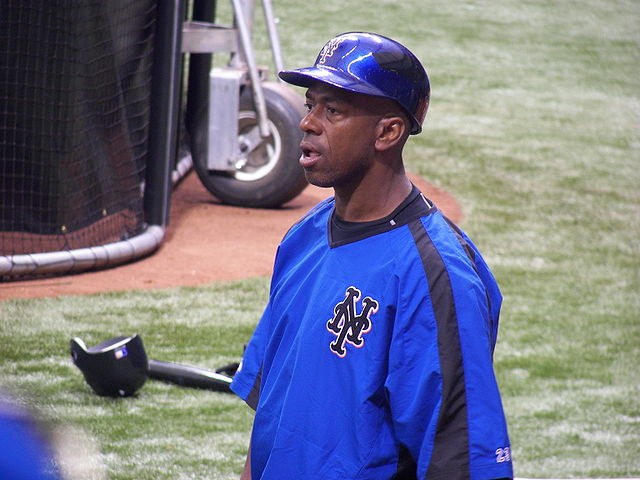
You won’t find Franco on any all-time lists or record-breaking performances, but the ageless journeyman deserves recognition for his work for eight MLB teams over more than 20 seasons.
Franco, whose batting stance was imitated by backyard sluggers through the Caribbean and U.S., was the all-time hits leader for Dominican players with 2,586, until he was passed by Vladimir Guerrero in 2011. Franco first rose to prominence with the Texas Rangers, where he was a three-time All-Star and won an AL batting title in 1991. After a knee injury in 1992, however, Franco became primarily a designated hitter, and helped the Cleveland Indians win the American League pennant in 1997.
Franco, however, is also largely remembered for his later career, where he became an “iron man” of sorts. Playing in over 25 professional baseball seasons, Franco set records for the oldest man to hit a home run and the oldest pinch runner – accomplishing both at the age of 47 – while also becoming a fan favorite with the New York Mets. At the time of his retirement, Franco was widely regarded as one of the most consistent players in baseball.
Second Base:
Robinson Canó
San Pedro de Macorís
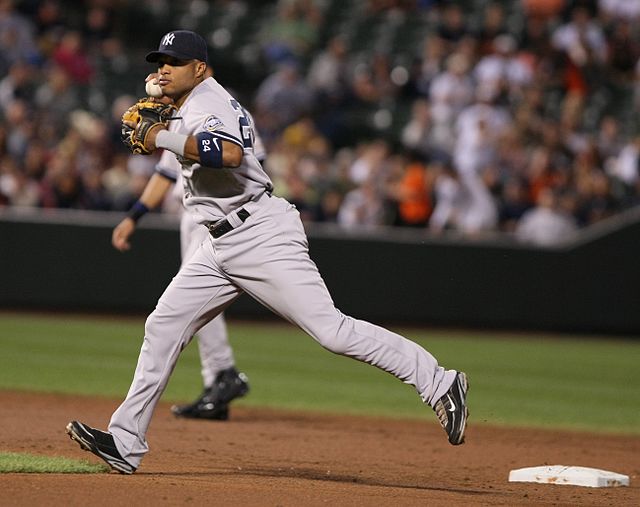
The hits leader of the 2010s, this slugger is well known in both Seattle and New York for his rhythmic, powerful swing and slick fielding.
First introduced as a dual threat for the Yankees in 2005, Canó instantly became an essential part of a new contending core for the New York Yankees, even making the final putout for the team in their 2009 World Series win. Canó would be named an All-Star over the next four seasons, and was a perennial MVP contender, finishing as high as third in 2010. In addition to four straight Silver Sluggers from 2010-2013, Cano would also win two Gold Gloves in 2010 and 2012.
Canó signed with the Seattle Mariners in 2013, and continued to produce for the Mariners, being named an All-Star three times. Despite time on the Injured List and a lengthy suspension due to Performance Enhancing Drugs (PEDs) in 2018, Canó would finish the 2010s leading all players in hits with 1,695.
Despite the resume, Canó’s chances at a Hall-of-Fame nod have been severely impacted by two suspensions as a result of PEDs. The impressive stats, smooth fielding, and pretty swing, however, are fantastic and should not be overlooked.
Alfonso Soriano
San Pedro de Macorís

A legendary talent that took an unusual path to Major League Baseball, Soriano was a fantastic hitter that also applied his speed and athleticism in the field and on the basepaths.
First signed by the Hiroshima Toyo Carp, Soriano was brought to the Yankees in an international deal that reshaped the relationship between MLB and Nippon Professional Baseball. The prospect did not disappoint over his first full MLB season, coming third in Rookie of the Year voting, and proceeded to excel at each stop of his career. He put together a fantastic stretch of All-Star seasons: seven straight years, despite being on four different teams.
One of only four players in the “40-40” club for his single-season home run and stolen base totals (and the only one whos career isn’t clouded by PEDs), Soriano was both a power-hitter and presence on the bases, causing headaches for pitchers defenses across the league. Finally finding a longtime home with the Chicago Cubs in 2007, Soriano quickly became the keystone of a new core on the North Side, but his performance dropped off as the 2010s wore on.
One of the most dynamic offensive players ever, however, should not be left off this list.
Plácido Polanco
Santo Domingo

A defensive stalwart and a Detroit Tigers fan favorite, Polanco is an underrated commodity that deserves way more attention.
Posting a .993 fielding percentage at second base and .983 at third (both record-highs in MLB history) Polanco was almost impenetrable in the infield. His steady glove instilled confidence in his pitchers, and his understated presence certainly played a key role in the Detroit Tigers’ mid-2000s playoff runs. Winning three Gold Gloves and being named an All-Star twice, the second-baseman needs more recognition for his defensive work.
Polanco, however, was also a consistent performer at the plate, notching 2,142 total hits over 16 MLB seasons. While he may not have had the flash or glitz of other players on this list, he was almost a certainty to perform, a quality that cannot be overlooked.
Luis Castillo
San Pedro de Macorís

A true all-around player and a Florida Marlins legend, Castillo is a model player for both his defense and offensive prowess, earning several accolades for both.
Debuting for the Marlins in 1996, Castillo rose to prominence in 2000, when he led the National League in stolen bases. It wasn’t until 2002, however, that the second baseman became a bonafide star; he once again led the NL in stolen bases, won his first Gold Glove, and earned his first All-Star nod. He would continue this dominance over the next four years, winning two more Gold Gloves and earning two more All-Star selections, as well as a World Series ring in 2003.
In 15 MLB seasons, Castillo posted a .984 fielding percentage and a .368 on-base percentage; he was an exemplary all-around player. Again, while not wowing anyone with dominance except for on the basepaths, Castillo is a Marlins legend for several factors, and deserves recognition for his work.
Shortstop:
Tony Fernández
San Pedro de Macorís
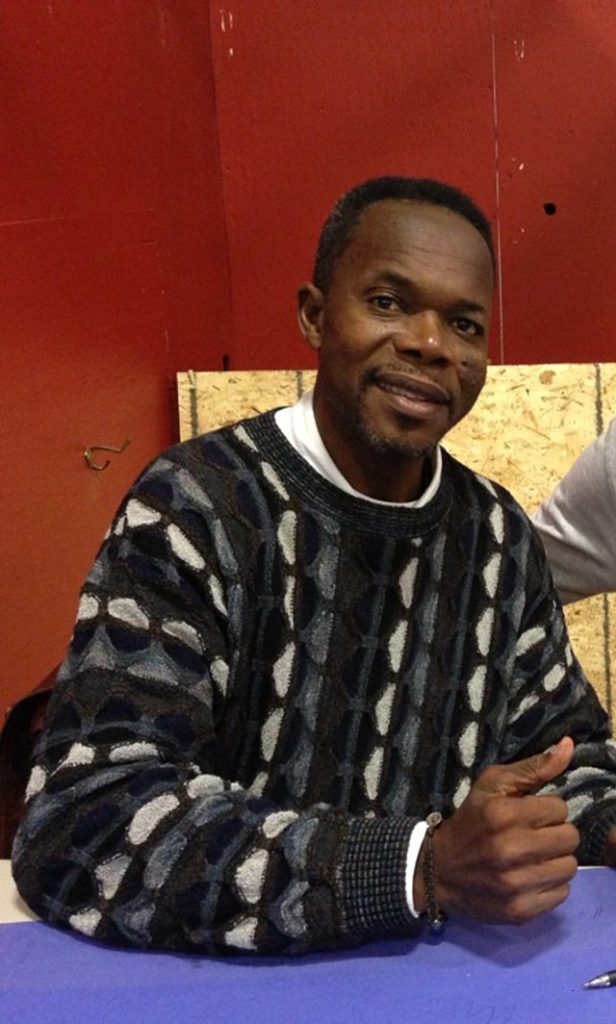
One of the most important players in Toronto Blue Jays’ history, Fernández was a fantastic shortstop for the Canadian club, while also posting productive numbers with the stick.
First earning his stripes in 1983, Fernández posted a legendary performance in 1986, winning his first of four straight Gold Gloves and notching the then-highest hit total by a shortstop with 213. He would also post a .992 fielding percentage in 1989, one of the highest by a shortstop in MLB history, and continue to carry his weight over the next 10 MLB seasons.
Fernández, however, is most widely known for his role on the 1993 Blue Jays’ World Series title. During the Series, Fernandez batted .333 and drove in nine runs, then a record for a shortstop. His role for the Jays would earn him the Level of Excellence for Toronto, while also being named to the Ontario Sports Hall of Fame in 2016.
Miguel Tejada
Baní
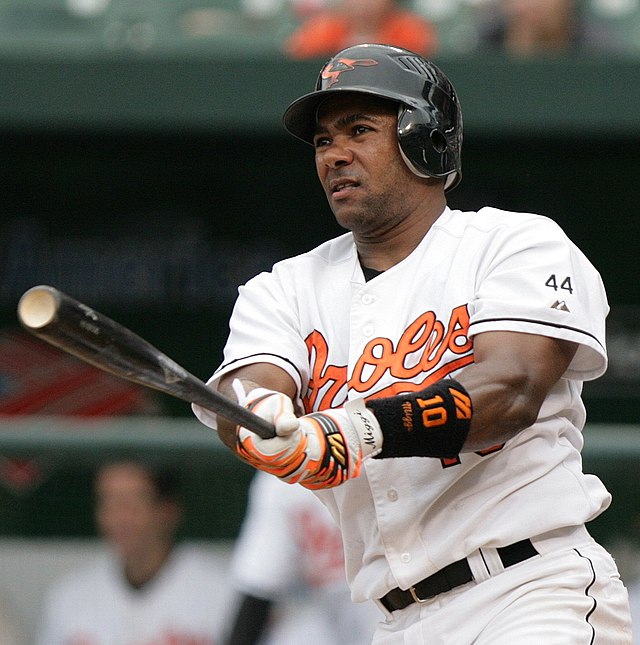
Nicknamed “La Guagua” or “The Bus” for his ability to drive in runs, Tejada was a presence to be reckoned with at the plate in the early 2000s, winning the AL MVP in 2002 and leading the American League in RBIs in 2004.
One of the most important players on the Moneyball” A’s, Tejada was at his best in 2002, helping the team win 20 consecutive games with 31 home runs, 131 RBIs and clutch hits galore. Playing in 162 games in six consecutive seasons, Tejada showed up to play every day and was one of the most consistent star players of the 2000s, earning six All-Star nods in addition to his MVP and RBI title.
While also mired by PED charges, Tejada was an absolute force in the 2000s, one that makes him impossible to leave off this list.
José Reyes
Villa González, Santiago
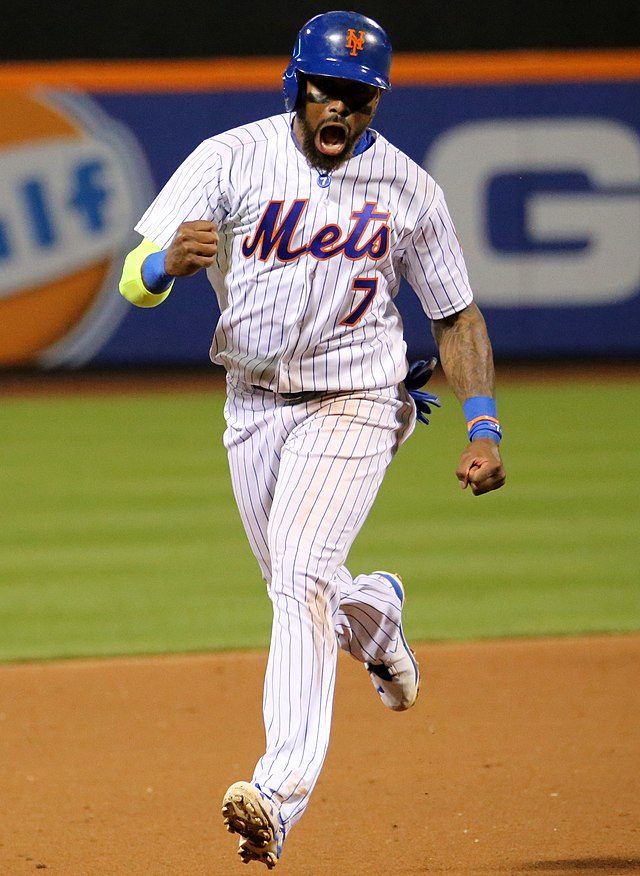
A speed demon on the basepaths and an important Mets figure, Reyes led the National League in stolen bases in three straight seasons from 2005 to 2007, as well as leading MLB in triples in 2005, 2006, 2008, and 2011.
Reyes was a game-changing player day in and day out in the 2000s, with his speed and skill with the bat making him exciting to watch on every play. With an uncanny ability to turn singles into doubles and doubles into triples, Reyes was a factor in almost every box score, scoring more than 100 runs and stealing more than 60 bases each season between 2005 and 2007.
Beyond the insane speed, the four-time All- Star was also a beloved figure for the Mets, often appearing on the jumbotron between innings as “Professor Reyes” and teaching those in attendance phrases in Spanish. A fantastic player and personality who deserves a nod for his havoc-wreaking speed alone.
Rafael Furcal
Loma de Cabrera

A three-time All-Star and winner of the 2000 NL Rookie of the Year, Furcal is another shortstop who wreaked havoc on the basepaths – and wasn’t too bad with the hitstick either.
Debuting for the Atlanta Braves in 2000, Furcal made an immediate impact by batting .295 and stealing 40 bases, garnering him the National League Rookie of the Year. He would continue these impressive performances over several years, including his first All-Star season in 2003, when he led the league in triples with 10 and batted .292, and later in Los Angeles, where he batted .300 in 2006 and was named an All-Star in 2010 for the Dodgers. He would later be traded to the St Louis Cardinals, where he won a World Series title in 2011 and was named an All-Star in 2012.
A dependable speed demon, Furcal in his prime would be an asset to any major league club.
Third Base:
Adrián Beltré
Santo Domingo

One of the greatest players in MLB history and arguably the top-hitting third baseman of all time, Beltré is almost guaranteed to be a Hall-of-Famer, with career achievements and awards galore.
The only Dominican member of the 3,000 hit club, Beltré was an absolute monster at the plate, hitting 100 home runs for three teams: the Los Angeles Dodgers, Seattle Mariners, and Texas Rangers. Beltré could truly do it all with the bat, leading the league in home runs with 48 in 2004, in hits with 199 in 2013, and in doubles in 2010 with 49. Beltré was also known for his savvy and aggressive style on the basepaths, hitting for the cycle three times and always posing a threat to turn any base hit into a double.
Beltré, however, was most impressive with the leather. He won five Gold Gloves and two “Platinum Gloves” (2011 and 2012) at third base due to his lighting-quick hands and feet and powerful arm.
He was only named an All-Star four times, which is not indicative of his body of work. Historically, Beltré ranks thirteenth in all-time defensive Wins Above Replacement for all players and is among the most respected talents and competitors in the game. All the skills, however, could not outshine Beltre’s infectious personality and joy for the game, often receiving as much attention for an unwelcome head pat (which Beltré despised) as he would for a game-winning knock. You’d be hard-pressed to determine who loved him more – his teammates or his hometown fans.
Beltré’s number has already been retired by the Texas Rangers, and it’ll likely be just a few more years before we see his career enshrined in Cooperstown.
Aramis Ramírez
Santo Domingo
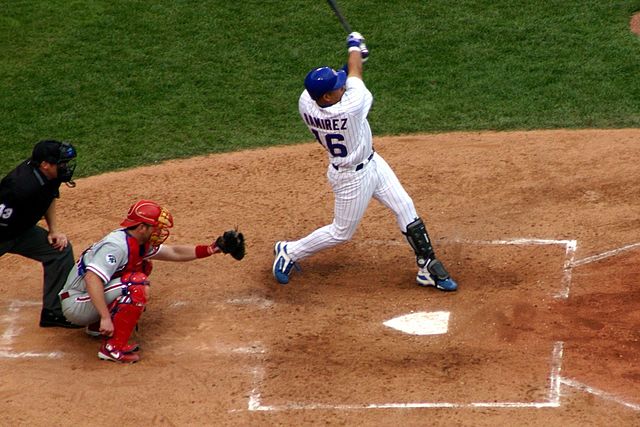
A Chicago Cubs fan-favorite and a feared hitter across the National League, Ramírez was an understated performer whose teammates and hometown fans fully appreciated his game.
Originally starting his career with the Pittsburgh Pirates in 1998, Ramírez was traded to the Cubs in 2003 and quickly became a clubhouse and fan favorite, due to his play at the plate and towering home runs. While he wasn’t the greatest fielder (his .929 fielding average in 2003 ranked lowest among National League third basemen) he often made up for it later with the game-winning hit.
Among his career highlights are: leading the Cubs in RBIs in 2007 and 2011, being named an All-Star three times (in 2005, 2008 and 2014), and earning the National League Hank Aaron Award in 2008, given to a player with the best offensive production in the league. Although he never had the postseason opportunity he deserved, Ramírez was at times an unbelievable player to watch at the plate, and deserves his place here among the other Dominican immortals.
Edwin Encarnación
La Romana

With a skill for clutch hitting and his “parrot” in tow, Encarnación has been one of the more clutch hitters of the 2010s. While he began his career with the Cincinnati Reds, Encarnación is more known for his time with the Toronto Blue Jays, where he was a three-time All-Star (2013, 2014, 2016) and one time American League RBI Leader (2016).
Along with fellow Dominican Jose Bautista – more on him later – Encarnación helped lead the Jays back to playoff relevance, with deep playoff runs in 2015 and 2016. He was a playoff hero in both runs, with home runs aplenty… including his monstrous AL Wild Card shot that sent the Jays into the Division Series.
Catchers:
Tony Peña
Monte Cristi
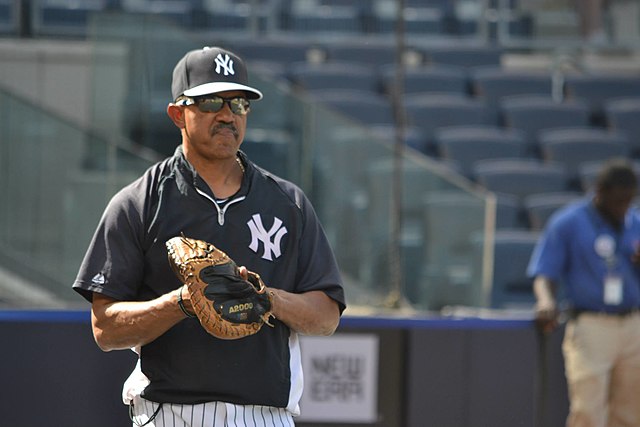
A member of the Caribbean Baseball Hall of Fame, Peña has had a storied career as both a catcher (winning four Gold Gloves) and a coach. We’ll talk about his catching now; more on the coaching in a later piece.
First rising to prominence as a member of the Pittsburgh Pirates, Peña was a sniper behind the plate, with his unorthodox squat and quick release allowing him to catch runners napping. With one of the best “Caught Stealing” percentages of all time (35%) and dishing 100 assists in 1985, almost no one could run on Peña, proving to be a major asset to the Pirates in the 80s.
Peña was an absolute model of consistency, being named an All-Star five times, and durability, rarely missing time due to injury; a rare feat for a catcher. With 1,950 games played, Peña currently sits at sixth all-time among MLB catchers, while also posting a career fielding percentage of .991. Although he was more remembered for his defense than his offense, he did have his fair share of good at-bats, including a memorable walk-off in the 1995 ALDS:
This defensive wizard is everything you want in a catcher, and the all-time Dominican team would not be complete without Peña behind the dish.
Carlos Santana
Santo Domingo

Santana may be more known as a first baseman, but with a backlog of future Dominican Hall of Famers at the position already, we had to have his bat off the bench as our backup catcher. He was primarily a catcher during his first four MLB seasons, after all.
Santana is one of the most disciplined hitters in recent history, leading MLB in walks in 2014 and the pandemic-shortened 2020 season. That isn’t to say Santana can’t hit at all, as he won a Silver Slugger in 2019, where he was also named an All-Star.
Beyond regular season accolades, Santana is a dedicated teammate and leader who isn’t afraid to do dirty work, whether that means destroying a television video game system in the clubhouse – which happened in 2018, when he was frustrated with his Phillies’ refusal to work to beat a losing streak – or his clutch hitting in postseason performances, including three important home runs in the Indians’ 2016 World Series run.
Check back here tomorrow for Part 2: Outfielders!















